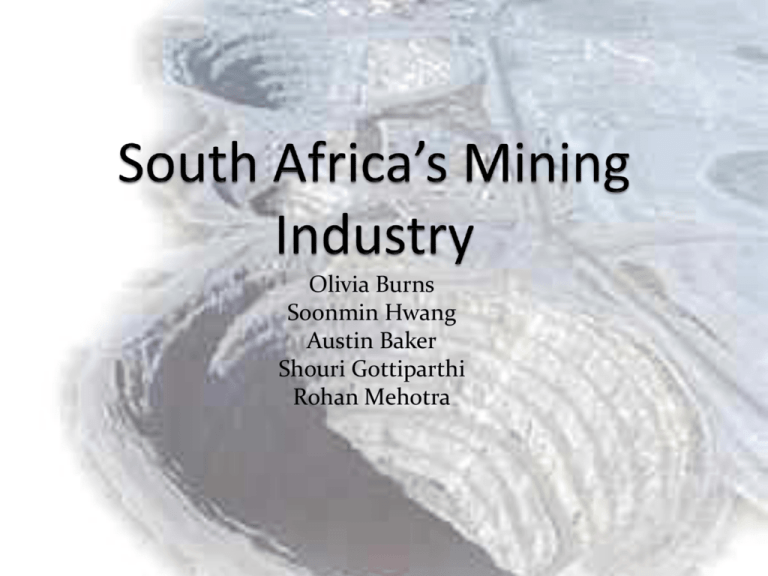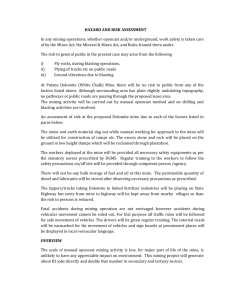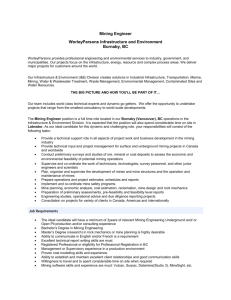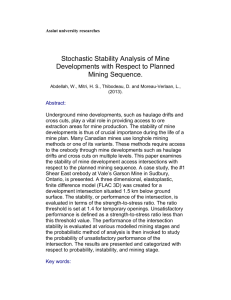Mining Industry in South Africa
advertisement

Olivia Burns Soonmin Hwang Austin Baker Shouri Gottiparthi Rohan Mehotra Development and History 1871 - Diamonds discovered at Kimberly Attracted substantial capital from British and European banks. 1886 - Main reef of the gold-bearing corporation was discovered on Langlaagte Farm, near Johannesburg. Did not set off usual gold rush because money was required to develop deep underground mines. 1898 - By this time, South Africa outputted 118 metric tonnes of gold, making them the leading producer. 1913 - The output rose to 280 tonnes after the Boer War Development and History (cont’d.) South Africa discovered major new extensions to the gold reefs every few decades 1930’s - ‘West Wits Line’ 1946-Orange Free State 1950’s-Evander 1970-Resources combined to make an output of 1,000 tonnes. This became hard to maintain. Costs to put down new shafts to even greater depths became high- priced ($2 billion over seven years). Output soon began to decline 1977 - 700 tonnes 1990 - 605 tonnes The South African mining industry in 1990 was to restructure itself and to adapt to the fast-changing political landscape at home. How did it work in the 1940’s? Conditions at many of the mines were terrible Witwaterstrand About 309,000 native workers Six day week on low pay with no overtime Had to pay for their own bedding and clothing Workers forced to move to mines Mostly if not all men Made to leave family and villages behind Lived in compounds with other workers Unions were small and divided until the beginning of the 1940’s Council of Non-European Trade Unions (CNETU) won some wage raises by 1945 1946 Strike African Mineworker’s Union About 76,000 workers Demands: Minimum daily wage of 10 shillings Family housing Two weeks of paid leave per year Repeal of War Measure 145 Made meetingos of 20+ illegal on mine property Restricted the organization of workers Was stopped by the government after a week How Does it Work Now? Items produced South Africa has the world’s largest reserves of chrome, gold, vanadium, manganese and PGM’s. Apart from diamonds, uranium, copper, and phosphate, South Africa produces more minerals than any other African country. Structure of the Mining Industry mining industry is still predominantly white controlled People are trying to empower blacks in the industry. Several black or union owned firms are now beginning to play an important role in the industry. Not much foreign investment since the country's first democratic elections in 1994 because of: Minerals legislation Uncertainty over the economic situation High crime rate. Many junior exploration companies are now active in developing several small to medium scale operations, mainly in diamonds, gold and platinum. How Does it Work Now? (cont’d.) Acid Mine Drainage Acid Mine Drainage (AMD) is currently one of the world's biggest environmental threats, second only to climate change according to the United States Environmental Protection Agency. The toxic effects of exposure to the water (from uranium and other heavy metals) include cancers, birth defects, kidney failure and mental disorders. There are major Acid Mine Drainage problems in South Africa that are causing many health risks. especially true in the area of Johannesburg. Mining’s Effects on the Population White population holds most of the country’s wealth They owned the major companies for a long time. Today - whites still control most of the economy Mining was one of several causes of racism along with colonialism and imperialism Apartheid (literally "separateness") was a system of racial segregation that was enforced in South Africa from 1948 to 1994. Non-white people prevented from voting Made to live in separate communities. Bibliography "Bound to Strike Back | South African History Online." South African History Online. Web. 26 Apr. 2012. <http://www.sahistory.org.za/archive/bound-strike-back>. Economy/History." South Africa. Web. 26 Apr. 2012. <http://www.english-online.at/geography/southafrica/geography-south-africa.htm>. "Mining Explained." Mining Journal -. Web. 27 Apr. 2012. <http://www.mining- journal.com/knowledge/MiningExplained>. "Mining in South Africa - Overview." MBendi.com. 26 Apr. 2012. Web. 26 Apr. 2012. <http://www.mbendi.com/indy/ming/af/sa/p0005.htm>. Moorehead, Monica. "The Great South African Mine Strike of 1946." Editorial. Workers World 29 Aug. 1996. Workers World. Web. 26 Apr. 2012. <http://www.workers.org/ww/1997/1946strike.html>. "Prejudice and Discrimination." Simply Psychology. Web. 26 Apr. 2012. <http://www.simplypsychology.org/prejudice.html>. "Problems in South Africa." World Map, Map of the World. Web. 26 Apr. 2012. <http://www.mapsofworld.com/south-africa/society/problems.html>. South Africa Mine Nationalization â€̃ closest since End of Apartheid†." South Africa Mine Nationalization 'closest since ™ End of Apartheid' Web. 26 Apr. 2012. <http://www.mining.com/2011/08/02/mine-ceos-told-south- africannationalization-closest-since-end-of-apartheid-even-as-police-probe-its-main-proponent/>. "South Africa – Mining History." GoldAvenue Encyclopaedia. Web. 26 Apr. 2012. <http://info.goldavenue.com/info_site/in_mine/in_min_sa_his.htm>. "South Africa - Transition 1990-2001." GoldAvenue Encyclopaedia. Web. 26 Apr. 2012. <http://info.goldavenue.com/info_site/in_mine/in_min_sa_trans.htm>.









